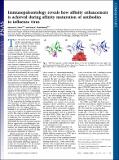Immunopaleontology reveals how affinity enhancement is achieved during affinity maturation of antibodies to influenza virus
Author(s)
Eisen, Herman N.; Chakraborty, Arup K
DownloadChakraborty-2013-Immuno-paleontology reveals how affinity enhancement is achieved during affinity maturation of antibodies to Influenza Virus.pdf (538.6Kb)
PUBLISHER_POLICY
Publisher Policy
Article is made available in accordance with the publisher's policy and may be subject to US copyright law. Please refer to the publisher's site for terms of use.
Terms of use
Metadata
Show full item recordAbstract
The Abs made by B lymphocytes on first encountering an antigen bind it with low intrinsic affinity, and, over time, the average affinity of the Abs made against that antigen gradually increases. These changes, known as affinity maturation, were found initially for serum antibodies that recognized small, chemically well-defined epitopes (e.g., 2,4-dinitrophenyl). That similar affinity increases occur in responses to protein antigens, which elicit most immune responses to infections or vaccination, has been generally assumed but difficult to prove (1) largely because of the complexity and multiplicity of epitopes (antigenic determinants) on even small, single-chain proteins (2). Though some protein epitopes are linear stretches of amino acids, they usually are configurational clusters of noncontiguous residues best delineated crystallographically in antibody–antigen complexes (3); and more often than not, the diverse antibodies elicited to a protein antigen bind to different epitopes on that protein (4), confounding efforts to convincingly demonstrate affinity maturation. There are at least five epitopes on the influenza virus hemagglutinin (HA) that binds the virions to host cells (5). By comparing the binding properties and structures of affinity matured Abs to one of the HA epitopes with those of their progenitor Abs, the elegant study by Schmidt et al. reported in PNAS (6) provides clear evidence for affinity maturation of Abs. The study is notable, moreover, for its focus on the human immune response to influenza virus vaccination with a conventional influenza seasonal vaccine (FLUZON flu shot). By bringing together diverse approaches (crystallography, molecular dynamics simulations, and kinetic studies), the authors shed intriguing light on how the affinity enhancement of affinity matured antibodies is achieved.
Date issued
2013-01Department
Massachusetts Institute of Technology. Institute for Medical Engineering & Science; Massachusetts Institute of Technology. Department of Biological Engineering; Massachusetts Institute of Technology. Department of Biology; Massachusetts Institute of Technology. Department of Chemical Engineering; Massachusetts Institute of Technology. Department of Chemistry; Massachusetts Institute of Technology. Department of Physics; Ragon Institute of MGH, MIT and Harvard; Koch Institute for Integrative Cancer Research at MITJournal
Proceedings of the National Academy of Sciences of the United States of America
Publisher
National Academy of Sciences (U.S.)
Citation
Eisen, H. N., and A. K. Chakraborty. “Immunopaleontology reveals how affinity enhancement is achieved during affinity maturation of antibodies to influenza virus.” Proceedings of the National Academy of Sciences (January 1, 2013). Copyright © 2013 National Academy of Sciences
Version: Final published version
ISSN
0027-8424
1091-6490